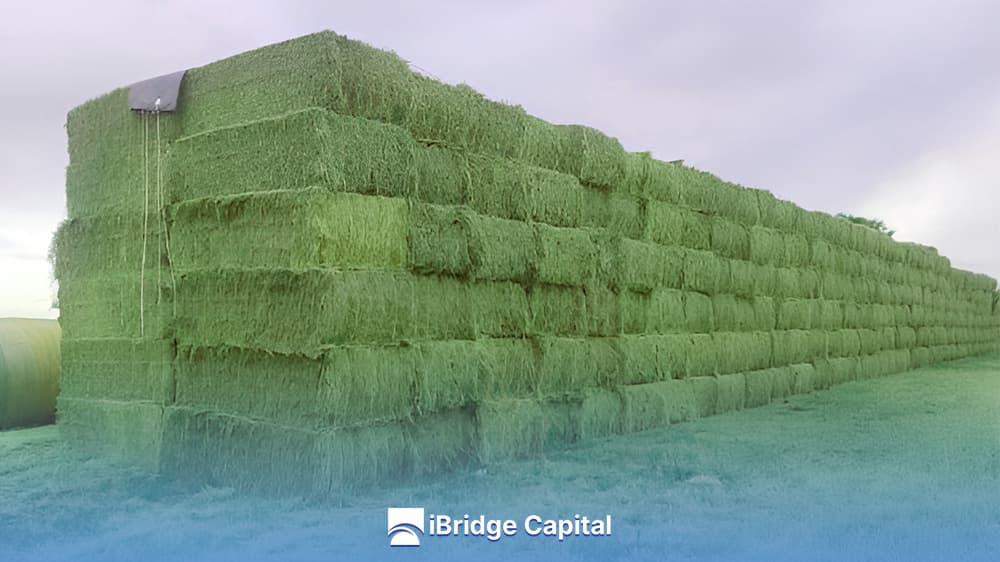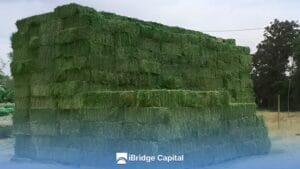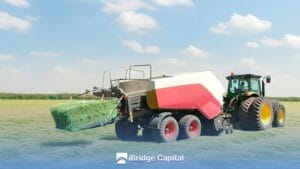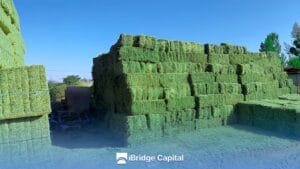Industrial alfalfa drying is a practice that is transforming the way forage producers manage their harvest. While traditional sun-drying has been the standard method for centuries, current technology allows for precise control of the process, which translates into a higher quality product and significant added value. If you’re wondering how to go from variable quality hay to export-grade hay, the answer lies in a technical alfalfa drying process.
What industrial drying is and why it’s essential
Industrial drying, also known as dehydration, is a method to reduce the moisture content of freshly cut alfalfa quickly and in a controlled manner. Unlike traditional hay drying, this process doesn’t depend on weather conditions. This is crucial, as sun-drying can compromise the quality of the forage if there is rain or excessive humidity. Alfalfa dehydration ensures that the final product retains its nutritional properties.
The importance of this technique becomes evident in the nutritional value. Artificially dried alfalfa hay maintains a much higher concentration of proteins and vitamins than naturally dried hay. This method allows you to produce top-quality dehydrated alfalfa, ideal for demanding markets and specialized livestock nutrition.
Differences between natural and artificial drying
The main difference between both methods lies in control. Field drying of alfalfa is at the mercy of the sun and wind. While it is the most economical method, it is also the riskiest. The forage can suffer damage from rain, discoloration from excessive sun, or the loss of leaves during the handling process. The natural hay drying process requires ideal weather conditions to be successful.
On the contrary, forage drying is done industrially under controlled conditions. Once the alfalfa is cut, it is transported to a drying plant where an alfalfa dryer is responsible for reducing the moisture to ideal levels. This method allows for cutting at an earlier phenological stage, when the plant’s nutritional value is at its maximum. This is a key point that differentiates artificially dried alfalfa hay from any other production.
Benefits of dehydrated alfalfa
Dehydrated alfalfa offers a series of benefits that make it a higher-value product.
- Higher nutritional value: Crude protein, non-structural carbohydrates, and vitamins are preserved.
- Uniform quality: The final product has consistent quality, which facilitates its commercialization.
- Better digestibility: The rapid reduction of moisture prevents the lignification of fibers.
- Lower risk: Production is not subject to unexpected weather.
- Longer shelf life: The low moisture of the final product gives it greater durability.
Furthermore, dehydrated alfalfa in pellets is easier to store, transport, and dose in rations for livestock. This simplifies logistics and makes the product more attractive to hay buyers.
The industrial alfalfa drying process, step by step
The alfalfa dehydration process is a meticulously planned chain of events. It is not just about cutting and drying but a series of stages that ensure the final product is of the highest possible quality.
From cutting to dehydration
The process begins in the field, where the alfalfa is cut at an early stage, generally at pre-bud. This ensures the maximum nutrient content. Unlike traditional alfalfa drying, which is left in the sun for several days, alfalfa for industrial drying is collected in a few hours. A brief wilting time is allowed to reduce the initial moisture from 75% to 50-60%. Then, it is loaded onto trucks and transported to the drying plant.
At the plant, the alfalfa is introduced into the machine for drying alfalfa, which is usually a rotary alfalfa dryer. Inside the dryer, the alfalfa is exposed to a current of hot air that reduces its moisture gradually and in a controlled manner to the desired level, generally between 10% and 12%. Hot air alfalfa drying is the most common method to preserve the nutritional properties of the forage.
The operation of a rotary drum dryer
The rotary drum dryer is the heart of the process. It is a large cylinder that rotates slowly. The alfalfa is introduced through one end, and as the drum rotates, a series of internal paddles lift and expose the forage to a current of hot air. The air temperature is a critical factor. A temperature that is too high can damage protein and vitamins, while one that is too low prolongs the process and increases costs.
Steam drying of alfalfa or other heating methods are used in some cases, but hot air is the most efficient and common. The process is meticulously controlled to ensure that the alfalfa does not burn or lose its value. The forage dryer is the machine responsible for this critical stage, where the final quality is defined.
Key machinery and technologies for forage drying
Forage drying on a large scale requires specialized equipment. The investment in the right machinery for drying alfalfa is fundamental to the plant’s efficiency and profitability. There are several options, each with its pros and cons, and the cost of drying alfalfa depends largely on the technology chosen.
Types of alfalfa dryers and their characteristics
In addition to rotary dryers, there are other types of dryers used in the industry.
- Belt dryers: The alfalfa is spread on a conveyor belt that passes through hot air tunnels. This method is slower but can be gentler on the forage. Belt drying of alfalfa is ideal for very high-quality products.
- Vertical silo dryers: This is a less common but efficient method for small batches. Vertical silo alfalfa drying uses fans to force hot air through a pile of hay, which is useful for smaller producers.
- Fan drying: This is a method that can be used in the field. It is based on forage drying with fans that inject hot air through a pile of hay, which is useful for smaller producers.
The forage dehydrator is the generic name for all this machinery. The choice of one or the other depends on the scale of production, the available investment, and the type of final product sought.
Alfalfa pelletizing process for added value
Once the alfalfa has been dried, it can be compacted into pellets. The alfalfa pelletizing process consists of grinding the dry hay and pressing it at high pressure. This forms small cylinders, known as pellets, which are denser, easier to handle, and store.
The alfalfa pelletizer is the machine that performs this stage. Alfalfa pellets for livestock are a product of great value, especially for export. Compaction increases density, which reduces transportation costs. Furthermore, how to make pelleted alfalfa ensures that animals receive a uniform ration, which is very important in modern animal nutrition.
How to optimize drying and the quality of the final product
The success of industrial alfalfa drying isn’t just about having the machinery but knowing how to use it. Process optimization is the key to achieving maximum quality and profitability.
The ideal alfalfa moisture for the process
The ideal moisture for alfalfa dehydration is a critical factor. Freshly cut alfalfa has a moisture content of 75-80%. Leaving it in the sun for a few hours until it drops to 50-60% reduces the time and cost of industrial drying. Alfalfa moisture at cutting is the highest, so this field pre-drying is a common practice.
On the other hand, hay moisture for baling in a traditional way must be much lower, ideally around 15-18%. In industrial drying, the final moisture of the product is even lower, at 10-12%, which ensures the stability and quality of the product.
Advantages of artificial alfalfa drying
The advantages of artificial alfalfa drying are numerous and are directly reflected in the final product.
- Leaf preservation: Quick and controlled handling reduces the loss of leaves, which are the most nutritious part of the plant.
- Product uniformity: A homogeneous product in terms of moisture and quality is obtained, which improves its commercialization.
- Independence from weather: You are not at the mercy of rain. This allows you to plan your harvest with greater precision.
- Fast availability: The fast alfalfa drying process allows the forage to be available for consumption in a matter of hours.
The value of pelleted alfalfa
Alfalfa pellets are more than just compacted hay. They are an added-value product that has found an important niche in the animal nutrition industry. While the machine for making alfalfa pellets is an additional investment, the return can be significant.
Benefits of pelleted alfalfa for livestock
Alfalfa pellets for livestock offer several benefits. They are easy to store and transport due to their high density. They are easy to dose in rations, which ensures precise nutrition. The benefits of dehydrated alfalfa for dairy cattle are especially notable, as this type of alfalfa helps maintain high milk production.
Pelleted alfalfa is also a way to ensure that animals consume all the forage, without discarding stems or less palatable parts, which translates into less waste and more efficiency.
Logistics and costs of dehydrated alfalfa in pellets
The alfalfa pellets price is offset by savings in transportation, the high density allows more product to be loaded into each truck or container, which reduces logistical costs the alfalfa pelletizing process for export is standardized to meet international requirements, which facilitates commercialization in global markets.
The machine for dehydrating alfalfa is a large initial investment, but the value of pelleted alfalfa in the export market usually justifies the investment in the medium and long term.
Comparison: industrial drying vs. field drying
The traditional method of alfalfa drying in the sun is a common practice, but it has significant disadvantages, especially when the goal is quality.
The disadvantages of natural hay drying
Windrow drying of alfalfa is vulnerable to rain. An unexpected rain can ruin a crop, causing economic losses. Excessive sun can bleach the hay and reduce its nutritional value. Repeated handling to turn the hay causes the loss of leaves, which are the part richest in protein.
Cut grass drying for traditional hay is a slow and risky process. The quality of the final hay is often inconsistent and difficult to guarantee. If you’re wondering how to dry alfalfa safely and efficiently, industrial drying is the answer.
How to avoid losses in the alfalfa drying process
Industrial alfalfa drying is the most effective method to avoid the losses associated with sun-drying. By quickly collecting the forage and processing it in an alfalfa dehydrator, losses due to rain and leaf detachment are avoided. The industrial hay dryer allows for temperature and moisture control, which ensures a high-quality final product.
Modern machinery for drying alfalfa, such as rotary dryers, are designed to maximize efficiency and reduce losses. This is crucial for the profitability of a forage operation.
Criteria for choosing the best drying machinery
Choosing the right machine for dehydrating alfalfa is a strategic decision. A good choice must consider efficiency, cost, and the quality of the final product.
Energy efficiency and yield per hour
Alfalfa drying with solar energy is an emerging technology, but most industrial dryers run on gas or liquid fuels. The energy efficiency of the alfalfa dryer is a determining factor in operating costs. An efficient machine can process more material per hour, which increases profitability.
The capacity of the machine, measured in tons per hour, must be commensurate with your production in the field. A machine that is too small will create bottlenecks, while one that is too large may not be profitable. That’s why the cost of drying alfalfa must be analyzed based on yield.
The cost of drying alfalfa and project viability
The investment in an industrial drying plant is considerable, but it should be seen as an investment in the quality and security of your production, the alfalfa dryers price varies greatly depending on their size and technology. However, the benefits of dehydrated alfalfa and the greater stability of the product price offset the investment.
A producer must perform a feasibility analysis to determine if industrial alfalfa drying is the right decision for their business. The greater control over quality and access to higher-value markets are the factors that tip the balance.
Conclusion
Industrial alfalfa drying is an evolutionary step in producing quality forage. Moving from a traditional method, exposed to the whims of the weather, to a controlled process allows you to guarantee a uniform and nutritious product.
The technology gives you the means to turn your alfalfa into a product of greater value, whether in the form of artificially dried hay or alfalfa pellets. We encourage you to consider this investment as a strategy to ensure profitability and quality in your production, regardless of the weather challenges.




